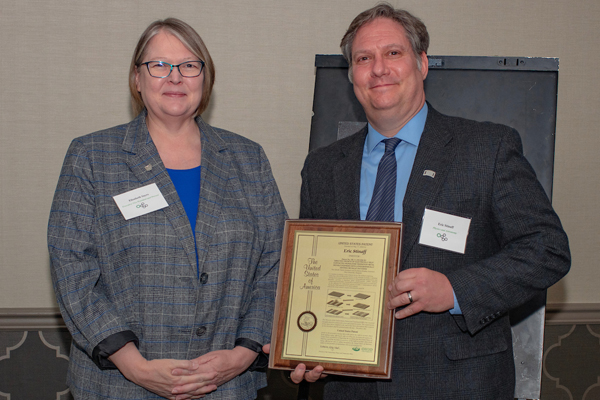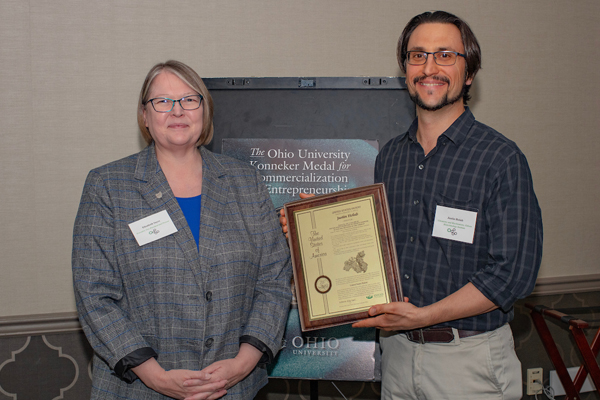Physicist Saw Hla’s major discovery could change not just the way scientists detect rare earth minerals, but also the future of nanomaterials, nanocomputing and nanomedicine.
College of Arts & Sciences Research
Explore Yesterday, Today & Tomorrow
College of Arts & Sciences faculty and students ask a lot questions in their pursuit of new knowledge.
Ohio University is an R1 research institution, and each year College of Arts & Sciences faculty and students produce dozens of books, hundreds of peer-reviewed articles, and hundreds of conference presentations in and across their disciplines.
Fundamental discoveries
from nanotechnology to the environment
Supported by grants ranging from NASA’s Mission to the Moon to the Department of Energy’s Rare Earth Minerals program, scientists are conducting experimental and theoretical research on today’s top questions.
-
Probing plant telomeres on NASA’s International Space Station
Molecular plant biologist Sarah Wyatt’s fifth experiment in the ISS’s microgravity environment is a three-university partnership to research the effect of space radiation on plant telomeres.
-
100-year-old collision theory doesn't stand up to 21st century calculations
Chemist Jixin Chen discovers new reaction rate in solution, with implications for industrial, biological processes.
-
Making graphite from coal?
As the world's appetite for carbon-based materials like graphite increases for uses such as electric vehicle batteries, physicist David Drabold presented evidence for a new carbon solid his team named "amorphous graphite."
-
Putting conservation into practice with Chesapeake Bay terrapins
Biologist Willem Roosenburg runs a multi-year project to help Maryland's diamondback terrapins make a comeback — thanks to an island that gives the turtles a haven free from most nest predators.
-
Finding two new species of violets in Northestern U.S.
Plant biologist Harvey Ballard’s new monograph describes two new species, plus “variants” that are yet to be classified.
Leading the fight against disease
Ohio University alumnus Venki Ramakrishnan won the 2009 Nobel Prize in Chemistry for his work showing the tiniest picture of life — how ribosomes use information encoded in DNA to assemble proteins that are the building blocks of life.
Fighting germs. Developing new drugs. Pursuing the cause of Alzheimer's, a cure for cancer, treatments for heart disease and diabetes. These are just a few of the pathways that OHIO faculty are aggressively pursuing.
-
Hiding in plain sight: Uncovering new class of medicinal compounds that target RNA
Chemistry students in Jennifer Hines' lab recently uncovered a new class of compounds that can target RNA and disrupt its function.
-
Taking the fight against a dangerous microbe to its RNA
Ronan Carroll's team is looking for ways to stop a potent killer, one that is getting adept at resisting antibiotics.
-
Tackling how pathogenic protein spreads in Parkinson's disease and Lewy body dementia
Daewoo Lee received a two-year $403,000 grant from the National Institutes of Health to probe how a pathogenic protein is able to spread from cell to cell in the brain.
-
Drugs, Diagnostics, Devices and Discoveries: Alumni leave a big footprint in health care
Science doesn't stand still, and neither do Ohio University alumni. They are inventing, creating, questioning, and contributing their research efforts to improve patient care.
Discovering history … one trowel at a time
Ohio University researchers are some of the world’s experts when it comes to discovering new dinosaur species and putting together the pieces of their environment left behind some 75-66 million years ago. But College of Arts & Sciences faculty are also hot on the trail of human history as well.
-
When did humans really arrival in the Americas?
A new analysis of archaeological sites challenges new theories that the earliest human inhabitants of North America arrived before the migration of people from Asia across the Bering Strait. Researchers suggest that misinterpretation of archaeological evidence at certain sites might be responsible for theories that humans arrived long before 13,000-14,200 years ago.
-
Why Ohio's history starts with first peoples and gets more complicated
When a best-seller tells part of the story about settling the Northwest Territory, enter Ohio University faculty to write the rest of the tale—starting 13,000 years ago with the first peoples arriving from the west and through efforts today by Eastern Shawnee Chief Glenna Wallace to get world heritage status for sacred sites in Ohio.
-
What our North American neighbors were up to during the U.S. Civil War
A new book examines the Civil War and Reconstruction by looking well beyond the battlefields of the eastern United States. While the new republic was in crisis, its North American neighbors had problems of their own. Mexico was embattled in its own civil war, and Britain’s North American colonies were in contested negotiations to form the Dominion of Canada.
Research Facilities
-
Edwards Accelerator LaboratoryThe Edwards Accelerator Laboratory's ion beams and upgraded time of flight tunnel make it uniquely positioned to get answers to some really important questions about understanding the universe.
-
OHIO Student FarmAthens, Ohio, is known for its 30-mile meal food ecosystem. Plant biology students aren’t just learning about sustainable food, they’re also growing it for area restaurants and food banks.
-
Genomics FacilityThe facility offers Next-Generation Sequencing services, Sanger sequencing, Fragment Analysis, qPCR, data analysis, and much more to the researchers of Ohio University as well as the outside research community.
-
Scalia Laboratory for Atmospheric AnalysisThis lab supports teaching and research in climatology, meteorology and forecasting. This lab maintains two weather stations, features Internet weather information systems, and provides local weather forecasts.


